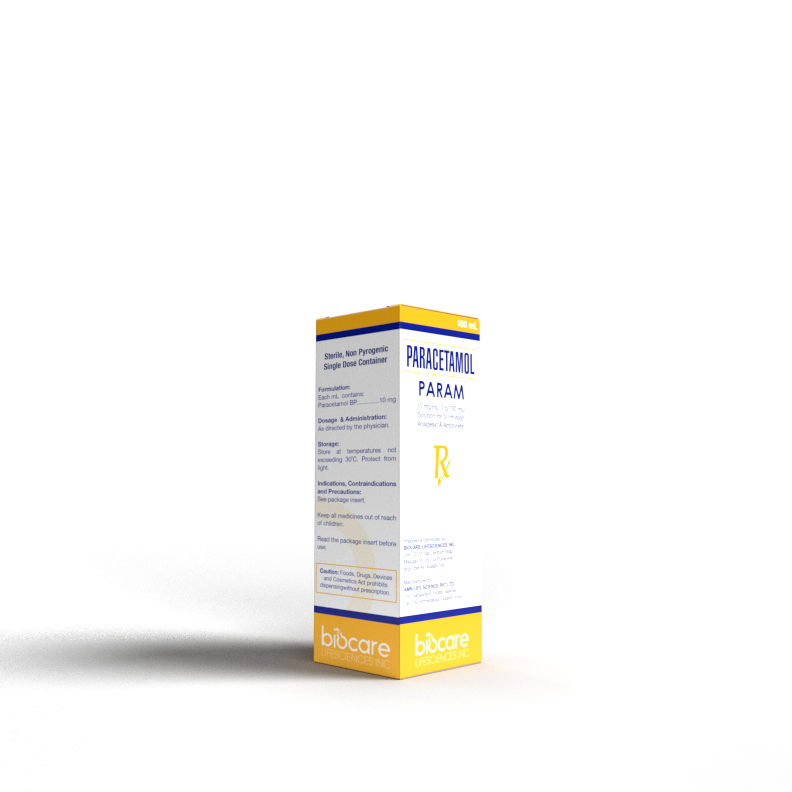PARAM

SILDENAFIL CITRATE
PARACETAMOL
PARAM
10 mg/mL(1 g/100 mL)
Solution for IV Infusion
Analgesic & Antipyretic
- Effective Pain Control in post-operative surgery.
- Rapid onset of action with 5-10 minutes.
- Ready to use formulation in a PLASTIC bottle.
- Proven effective with an assay test result of 99%.
- The pain is at calm with Param.
INDICATIONS
Paracetamol is indicated for the management of mild to moderate pain, management of moderate to severe pain with adjunctive opioid
analgesics, and for reduction of fever.
DOSAGE AND ADMINISTRATION
The Paracetamol solution is administered as a 15-minute intravenous infusion.
Adolescents and adults weighing more than 50 kg:
Paracetamol 1 g per administration, up to four times a day or 650 mg every 4 hours to a maximum of 4 g per day period minimum dosing interval of
4 hours.
Children, adolescents and adults weighing less than 50 kg :
Paracetamol 15 mg/kg per administration, i.e. 1.5 mL solution per kg up to four times a day or 12.5 mg/kg every 4 hours to a maximum of 75 mg/kg
per day. The minimum interval between each administration must be 4 hours.
“Severe renal insufficiency”: it is recommended, when giving Paracetamol to patients with severe renal impairment (creatinine clearance 30
mL/min), to increase the minimum interval between each administration to 6 hours.
“In adults with hepatocellular insufficiency, chronic alcoholism, chronic malnutrition (low reserves of hepatic glutathione) and dehydration, the
maximum daily dose must not exceed 3 g”
Contraindications
PARACETAMOL IS CONTRAINDICATED:
– in patients with hypersensitivity to Paracetamol or to proparacetamol hydrochloride (prodrug of paracetamol) or to any of the excipients
– in cases of severe hepatic impairment or severe active liver disease.
WARNINGS AND PRECAUTIONS
Doses higher than those recommended entail the risk of very serious liver damage hepatic injury, including the rise of liver failure and death.
Clinical signs and symptoms of liver damage (including fulminant hepatitis, hepatic failure, cholestatic hepatitis, cytolytic hepatitis) are usually first seen after two days of drug administration with a peak seen, usually after 4-6 days. Treatment with antidote should be given as soon as possible.
Paracetamol should only be used during pregnancy after a careful benefit-risk assessment. In this case, the recommended posology and duration
must be strictly observed.
After oral administration, paracetamol is excreted into breast milk in small quantities. No undesirable effects on nursing infants have been
reported. Consequently, paracetamol may be used in breast-feeding women.
DRUG INTERACTION
Probenecid causes an almost 2-fold reduction in clearance of paracetamol by inhibiting its conjugation with glucuronic acid. A reduction in the
paracetamol dose should be considered if it is to be used concomitantly with probenecid.
Salicylamide may prolong the elimination t1⁄2 of paracetamol.
Caution should be taken with the concomitant intake of enzyme-inducing substances.
SERIOUS ADVERSE EFFECTS:
- Hepatic injury
- Serious skin reactions
- Acute generalised exanthematous pustulosis (AGEP)
- Stevens-Johnson Syndrome (SJS)
- Toxic epidermal necrolysis (TEN)
- Allergy and hypersensitivity
- Swelling of the face, mouth and throat, respiratory distress, urticaria, rash, and pruritis.
MOST COMMON ADVERSE EFFECTS:
Gastrointestinal disorder: Nausea, Vomiting
General disorders and administration site conditions: Pyrexia
Nervous system disorders: Headache
Psychiatric: Insomnia
Other adverse effects in Adults:
Blood Lymphatic system disorders: anemia
General disorders and administration site conditions: fatigue, infusion site pain, peripheral edema
Investigations: Aspartate aminotransferase increases breath sounds abnormal
Metabolism and Nutrition disorders: Hypokalemia
Musculoskeletal and connective tissue disorders: muscle spasms, tissues
Psychiatric disorders: anxiety
Respiratory, thoracic and mediastinal disorders: dyspnea
Vascular disorders: hypertension, hypotension

Formulation
Each mL contains:
| Paracetamol BP |
|---|
| 10 mg |
View Complete Product Information
PARAM
10 mg/mL(1 g/100 mL) Solution for IV Infusion Analgesic & Antipyretic- Effective Pain Control in post-operative surgery.
- Rapid onset of action with 5-10 minutes.
- Ready to use formulation in a PLASTIC bottle.
- Proven effective with an assay test result of 99%.
- The pain is at calm with Param.
- Hepatic injury
- Serious skin reactions
- Acute generalised exanthematous pustulosis (AGEP)
- Stevens-Johnson Syndrome (SJS)
- Toxic epidermal necrolysis (TEN)
- Allergy and hypersensitivity
- Swelling of the face, mouth and throat, respiratory distress, urticaria, rash, and pruritis.


